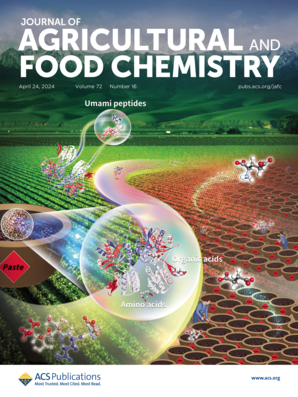9β-羟基ageraphoron通过上调MYB和DOF基因激活SA信号通路增强烟草对TMV的抗性
IF 6.2
1区 农林科学
Q1 AGRICULTURE, MULTIDISCIPLINARY
引用次数: 0
摘要
烟草花叶病毒(TMV)对全球烟草生产构成重大威胁。本研究采用半叶法对从Ageratina adenophora中分离得到的9个倍半萜类化合物的抗tmv活性进行了研究。其中化合物1 (9β-羟基ageraphorone)在50 μg/mL时的治疗效果最高(42.97%),失活效果较好(48.87%)。进一步的研究表明,化合物1破坏了TMV颗粒的完整性,并通过与病毒外壳蛋白的氢键和疏水相互作用加速了病毒粒子的聚合。此外,它上调水杨酸(SA)水平,增强PAL、POD和SOD的活性。转录组分析和qRT-PCR分析进一步表明,化合物1上调胁迫应答基因特别是MYB和LBD,激活SA信号通路,导致抗病转录因子和蛋白的表达升高,从而增强烟草对TMV的抗性。这些发现突出了9β-羟基ageraphorone作为一个有前途的候选植物抗病毒药物,有助于开发生态友好型作物保护策略。本文章由计算机程序翻译,如有差异,请以英文原文为准。

9β-Hydroxy-Ageraphoron Enhances TMV Resistance in Tobacco by Activating the SA Signaling Pathway through Upregulation of MYB and DOF Genes
Tobacco mosaic virus (TMV) poses a significant threat to global tobacco production. In this study, nine sesquiterpenoids isolated from Ageratina adenophora were evaluated for their anti-TMV activity using the half-leaf method. Among them, compound 1 (9β-hydroxy-ageraphorone) demonstrated the highest therapeutic (42.97%) and superior inactivation (48.87%) efficacy at 50 μg/mL. Further studies revealed that compound 1 disrupted TMV particle integrity and accelerated virion polymerization via hydrogen bonding and hydrophobic interactions with the viral coat protein. Additionally, it upregulated salicylic acid (SA) levels and enhanced the activities of PAL, POD, and SOD. Transcriptome and qRT-PCR analyses further indicated that compound 1 upregulated stress-responsive genes particularly MYB and LBD and activated the SA signaling pathway, leading to elevated expression of disease-resistant transcription factors and proteins, thereby enhancing TMV resistance in tobacco. These findings highlight 9β-hydroxy-ageraphorone as a promising candidate for botanical antiviral agents, contributing to the development of eco-friendly crop protection strategies.
求助全文
通过发布文献求助,成功后即可免费获取论文全文。
去求助
来源期刊
CiteScore
9.90
自引率
8.20%
发文量
1375
审稿时长
2.3 months
期刊介绍:
The Journal of Agricultural and Food Chemistry publishes high-quality, cutting edge original research representing complete studies and research advances dealing with the chemistry and biochemistry of agriculture and food. The Journal also encourages papers with chemistry and/or biochemistry as a major component combined with biological/sensory/nutritional/toxicological evaluation related to agriculture and/or food.

 求助内容:
求助内容: 应助结果提醒方式:
应助结果提醒方式:


